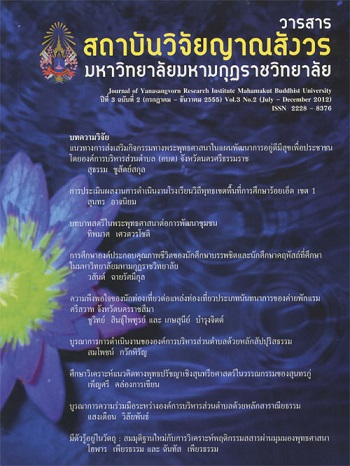Integration of Coopertion Among Sub-District Administration Organizations With Sãrãniya Dhamma
Main Article Content
Abstract
There are 4 aims of this thesis: 1) to study the cooperation among sub-district administration organizations, 2) to study Sãrãniya Dhamma, 3) to integrate cooperation among sub-district administration organizations with Sãrãniya Dhamma, and 4) to present a new model of “Integration of cooperation among sub-district administration organizations with Sãrãniya Dhamma”. This research is a qualitative approach collecting data from the Tipitaka, Buddhist scriptures, academic works and in-depth interview with 11 presidents of Tambol Administration Organizations in Chachoengsao province. The results of the study show that: 1. Cooperation among Sub-district Administration Organizations includes four aspects: 1) policy, 2) public service, 3) budget management, and 4) personnel management. 2. Sãrãniya Dhamma consists of six principles: 1) To be amiable in deed, 2) To be amiable in word, 3) To be amiable in thought, 4) To share any lawful gains with virtuous fellows, 5) To keep without blemish the rules of conduct along with one’s fellows, and 6) To be endowed with right views along with one’s fellows. 3. The cooperation among Tambol Administration Organizations integrated with Sãrãniya Dhamma could give good results as follows: 1) the policy setting integrated with Sãrãniya Dhamma item 4 and 5 will be fair and relevant to the public needs. 2) The public service integrated with Sãrãniya Dhamma item 1, 2, 3, 5, and 6 will be focused on the benefits of people rather than the bias for colleagues and fellows. 3) The budget management integrated with Sãrãniya Dhamma item 1, 2, 3, 5, and 6 can create unity and cooperation in team-working. 4) The personnel management integrated with Sãrãniya Dhamma item 4, 5, and 6 will result to merit system in personnel recruitment in workplace and the organizations can obtain qualified staff. 4. The new knowledge gained from the study can be concluded with "HSD” model. H is for Harmony, S for Success, and D for Development. The model shows that organizations should firstly encourage harmony among their members or teams in work, then followed by proceeding the work to its target, and finally development in work will occur.
Article Details
References
พระธรรมปิฎก (ประยุทธ์ ปยุตโต). พุทธศาสนากับสังคมไทย. พิมพ์ครั้งที่ 2. กรุงเทพมหานคร : สำนักพิมพ์มูลนิธิโคมคีมทอง, 2532.
มหาดไทย, กระทรวง. พระราชบัญญัติสภาตำบลและองค์การบริหารส่วนตำบล พุทธศักราช 2537. กรุงเทพฯ : โรงพิมพ์ส่วนท้องถิ่น, 2537.
ส่งเสริมการปกครองท้องถิ่น, กรม. คู่มือความร่วมมือระหว่างองค์กรปกครองส่วนท้องถิ่น.กรุงเทพมหานคร : โรงพิมพ์ส่วนท้องถิ่น, 2548.
อุทัย หิรัญโต. การปกครองท้องถิ่น. กรุงเทพมหานคร : โรงพิมพ์โอเดียนสโตร์, 2523


